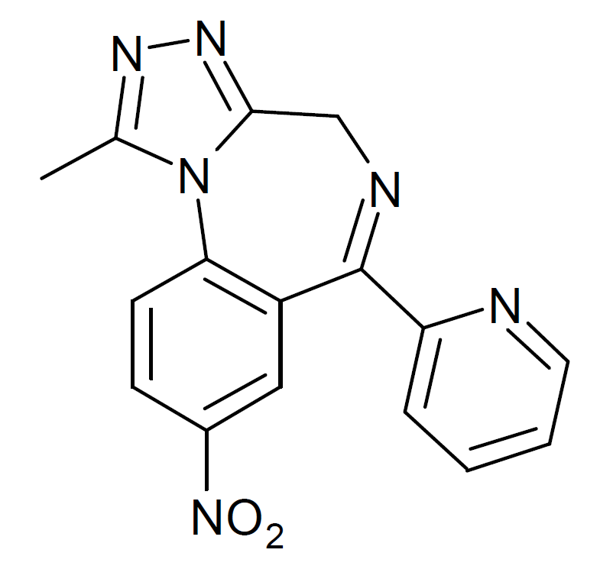Your cart is currently empty!
Clobromazolam
Clobromazolam (Phenazolam, DM-II-90, BRN 4550445), also known as phenazolam, is a powerful benzodiazepine with pronounced sedative and hypnotic properties. Synthesized in the 1980s, it has recently emerged as a designer drug with effects superior to many traditional benzodiazepines. Phenazolam enhances the effect of gamma-aminobutyric acid (GABA), the main inhibitory neurotransmitter of the brain, which leads…
Select Size
Select Color
Description
Chemically, clobromazolam (Phenazolam, DM-II-90, BRN 4550445) is known as 8-bromo-6-(2-chlorophenyl)-1-methyl-4H-[1,2,4]triazolo[4,3-a][1,4]benzodiazepine. Despite the fact that it was synthesized in the early 1980s, clinical use has not been developed. However, it was recently discovered on the Internet as a designer drug and identified during forensic studies of seized samples, for example, in Sweden in March 2016. This compound belongs to the class of benzodiazepines known for their effects on the central nervous system, including sedative, muscle-relaxing, anxiolytic and anticonvulsant properties.
Chemical properties and mechanism of action
Clobromazolam is structurally related to other benzodiazepines such as bromazolam and clonazolam. Its molecular formula is C17H12BrClN4, and its molecular weight is 387.7 g/mol. It contains a triazole ring connected to a benzodiazepine core, which determines its pharmacological activity.
Like other benzodiazepines, phenazolam enhances the effect of GABA on GABAA receptors. GABA is the main inhibitory neurotransmitter in the brain, and its increased activity leads to hyperpolarization of neurons, reducing their excitability. This mechanism underlies the sedative, anxiolytic, and muscle relaxant effects of benzodiazepines. By binding to the benzodiazepine site of the GABAA receptor, phenazolam enhances the natural calming effect of GABA on the central nervous system, making it a powerful depressant.
Pharmacokinetics and dosage
The pharmacokinetics of clobromazolam, including its absorption, distribution, metabolism, and elimination, are poorly understood due to its recent emergence as a designer drug. It is assumed that it has properties similar to other benzodiazepines, which are usually well absorbed by oral administration, reaching maximum plasma concentrations within 1-3 hours. Benzodiazepines are widely distributed throughout body tissues, binding to plasma proteins and accumulating in adipose tissues due to their lipophilicity.
The metabolism of phenazolam probably occurs in the liver with the participation of cytochrome P450 enzymes, which convert it into various metabolites, some of which may retain pharmacological activity. The half-life of phenazolam is unknown, but it is assumed that it is in the range typical for benzodiazepines, from several hours to several days, depending on the metabolic rate and individual characteristics.
Due to its high efficacy and lack of standardized dosage recommendations, phenazolam poses a significant risk when consumed. Some reports indicate that even small doses can cause a pronounced sedative effect. Users experimenting with this substance usually take it orally, although the specific dosage can vary greatly. Given its effectiveness, there is a high probability of overdose, especially when used concomitantly with other CNS depressants such as alcohol or opioids.
Effects and side effects
The main effects of phenazolam are similar to other benzodiazepines, although they have increased activity. These include:
Sedation and hypnosis: Phenazolam causes severe sedation, leading to drowsiness, and at higher doses— sleep.
Anxiolysis: Reduces anxiety, which may contribute to its abuse in people seeking to cope with anxiety disorders on their own.
Muscle relaxation: Has muscle relaxants
Currently, phenazolam is not included in the list of prohibited substances under the US Controlled Substances Act, however, in a number of countries, such as Serbia and Italy, its use is prohibited due to the high likelihood of abuse and lack of recognized medical value. It is important to consider the legal status of this substance in a particular region, as its storage or distribution may entail legal liability.
Conclusion
Phenazolam is a powerful and potentially dangerous benzodiazepine that has gained popularity in the designer drug market. Although its sedative and anxiolytic effects may seem attractive, it carries serious risks, including cognitive impairment, addiction, and overdose. Due to the lack of medical supervision and established dosing standards, its use poses a serious threat to health. Awareness of harm reduction strategies, as well as possible legal consequences, is extremely important for users.
Technical Information:
Product Name: Clobromazolam
Synonyms: Phenazolam, Clobromazolam, BRN 4550445, DM-II-90
CAS: 87213-50-1
IUPAC: 8-bromo-6-(2-chlorophenyl)-1-methyl-4H-[1,2,4]triazolo[4,3-a][1,4]benzodiazepine
Molecular Formula: C17H12BrClN4
Molecular Weight: 387.7 g/mol
Purity: 98.0 % min.
Formulations: A crystalline solid
Solubility:
- DMF: 30 mg/ml
- DMF:PBS(pH 7.2)(1:1): 0.5 mg/ml
- DMSO: 20 mg/ml
- Ethanol: 10 mg/ml
SMILES: CC1=NN=C2N1C3=C(C=C(C=C3)Br)C(=NC2)C4=CC=CC=C4Cl
Stability: ≥ 4 years

You can buy Cychlorphine online from ChainChemical right now! Our company has extensive scientific experience in chemical research and market trading.
Shopping at ChainChemical:
Proven and tested products.
A unique selection of products for research and scientific solutions.
High quality and optimal cost.
A chemical product of 98-99% purity packaged in an aluminum foil bag.
Payment using Bitcoin, Monero, Etherium, Litecoin, USDT and other cryptocurrencies.







Guido –
Where do you ship your products from? I want to buy a small package of clobromazolam to begin with.
admin –
Our experts have sent you a reply to the e-mail indicated in the comment. Please check it out and if you have any questions, do not hesitate to e-mail us.
Chaim –
Are you shipping clobromazolam to the USA?
I am ready to make a purchase after your response.
admin –
Our experts have sent you a reply to the e-mail indicated in the comment. Please check it out and if you have any questions, do not hesitate to e-mail us.